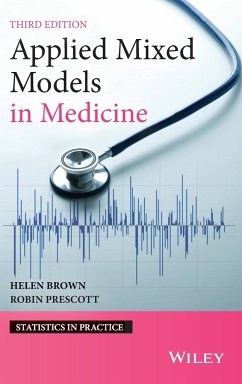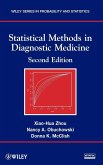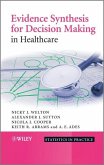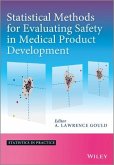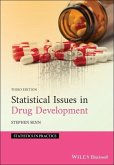- Gebundenes Buch
- Merkliste
- Auf die Merkliste
- Bewerten Bewerten
- Teilen
- Produkt teilen
- Produkterinnerung
- Produkterinnerung
A fully updated edition of this key text on mixed models, focusing on applications in medical research
The application of mixed models is an increasingly popular way of analysing medical data, particularly in the pharmaceutical industry. A mixed model allows the incorporation of both fixed and random variables within a statistical analysis, enabling efficient inferences and more information to be gained from the data. There have been many recent advances in mixed modelling, particularly regarding the software and applications. This third edition of Brown and Prescott's groundbreaking text…mehr
Andere Kunden interessierten sich auch für
![How to Design, Analyse and Report Cluster Randomised Trials in Medicine and Health Related Research How to Design, Analyse and Report Cluster Randomised Trials in Medicine and Health Related Research]() Michael J. CampbellHow to Design, Analyse and Report Cluster Randomised Trials in Medicine and Health Related Research112,99 €
Michael J. CampbellHow to Design, Analyse and Report Cluster Randomised Trials in Medicine and Health Related Research112,99 €![Statistical Methods in Diagnostic Medicine Statistical Methods in Diagnostic Medicine]() Xiao-Hua ZhouStatistical Methods in Diagnostic Medicine155,99 €
Xiao-Hua ZhouStatistical Methods in Diagnostic Medicine155,99 €![Understanding and Conducting R Understanding and Conducting R]() Christopher J. L. CunninghamUnderstanding and Conducting R158,99 €
Christopher J. L. CunninghamUnderstanding and Conducting R158,99 €![MAS Clinical Trials v1 MAS Clinical Trials v1]() MAS Clinical Trials v1241,99 €
MAS Clinical Trials v1241,99 €![Evidence Synthesis for Decision Making in Healthcare Evidence Synthesis for Decision Making in Healthcare]() Nicky J. WeltonEvidence Synthesis for Decision Making in Healthcare94,99 €
Nicky J. WeltonEvidence Synthesis for Decision Making in Healthcare94,99 €![Statistical Methods for Evaluating Safety in Medical Product Development Statistical Methods for Evaluating Safety in Medical Product Development]() Statistical Methods for Evaluating Safety in Medical Product Development101,99 €
Statistical Methods for Evaluating Safety in Medical Product Development101,99 €![Statistical Issues in Drug Development Statistical Issues in Drug Development]() Stephen S. SennStatistical Issues in Drug Development138,99 €
Stephen S. SennStatistical Issues in Drug Development138,99 €-
-
-
A fully updated edition of this key text on mixed models, focusing on applications in medical research
The application of mixed models is an increasingly popular way of analysing medical data, particularly in the pharmaceutical industry. A mixed model allows the incorporation of both fixed and random variables within a statistical analysis, enabling efficient inferences and more information to be gained from the data. There have been many recent advances in mixed modelling, particularly regarding the software and applications. This third edition of Brown and Prescott's groundbreaking text provides an update on the latest developments, and includes guidance on the use of current SAS techniques across a wide range of applications.
Presents an overview of the theory and applications of mixed models in medical research, including the latest developments and new sections on incomplete block designs and the analysis of bilateral data.
Easily accessible to practitioners in any area where mixed models are used, including medical statisticians and economists.
Includes numerous examples using real data from medical and health research, and epidemiology, illustrated with SAS code and output.
Features the new version of SAS, including new graphics for model diagnostics and the procedure PROC MCMC.
Supported by a website featuring computer code, data sets, and further material.
This third edition will appeal to applied statisticians working in medical research and the pharmaceutical industry, as well as teachers and students of statistics courses in mixed models. The book will also be of great value to a broad range of scientists, particularly those working in the medical and pharmaceutical areas.
Hinweis: Dieser Artikel kann nur an eine deutsche Lieferadresse ausgeliefert werden.
The application of mixed models is an increasingly popular way of analysing medical data, particularly in the pharmaceutical industry. A mixed model allows the incorporation of both fixed and random variables within a statistical analysis, enabling efficient inferences and more information to be gained from the data. There have been many recent advances in mixed modelling, particularly regarding the software and applications. This third edition of Brown and Prescott's groundbreaking text provides an update on the latest developments, and includes guidance on the use of current SAS techniques across a wide range of applications.
Presents an overview of the theory and applications of mixed models in medical research, including the latest developments and new sections on incomplete block designs and the analysis of bilateral data.
Easily accessible to practitioners in any area where mixed models are used, including medical statisticians and economists.
Includes numerous examples using real data from medical and health research, and epidemiology, illustrated with SAS code and output.
Features the new version of SAS, including new graphics for model diagnostics and the procedure PROC MCMC.
Supported by a website featuring computer code, data sets, and further material.
This third edition will appeal to applied statisticians working in medical research and the pharmaceutical industry, as well as teachers and students of statistics courses in mixed models. The book will also be of great value to a broad range of scientists, particularly those working in the medical and pharmaceutical areas.
Hinweis: Dieser Artikel kann nur an eine deutsche Lieferadresse ausgeliefert werden.
Produktdetails
- Produktdetails
- Statistics in Practice
- Verlag: Wiley & Sons
- Artikelnr. des Verlages: 1W118778250
- 3. Aufl.
- Seitenzahl: 544
- Erscheinungstermin: 9. Februar 2015
- Englisch
- Abmessung: 235mm x 157mm x 33mm
- Gewicht: 923g
- ISBN-13: 9781118778258
- ISBN-10: 1118778251
- Artikelnr.: 41024736
- Herstellerkennzeichnung
- Libri GmbH
- Europaallee 1
- 36244 Bad Hersfeld
- gpsr@libri.de
- Statistics in Practice
- Verlag: Wiley & Sons
- Artikelnr. des Verlages: 1W118778250
- 3. Aufl.
- Seitenzahl: 544
- Erscheinungstermin: 9. Februar 2015
- Englisch
- Abmessung: 235mm x 157mm x 33mm
- Gewicht: 923g
- ISBN-13: 9781118778258
- ISBN-10: 1118778251
- Artikelnr.: 41024736
- Herstellerkennzeichnung
- Libri GmbH
- Europaallee 1
- 36244 Bad Hersfeld
- gpsr@libri.de
Helen is a West Coast Canadian-born author who has an intense love for outdoor adventures, including remote, rugged hiking, mountain biking, backcountry skiing, and a variety of water activities. She believes that being alone in such beautiful natural surroundings has strengthened her devotion, love, and gratitude to God. Helen also loves to share these adventures with her husband and family.
Preface to third edition xiii Mixed models notation xvii About the Companion Website xix 1 Introduction 1 1.1 The use of mixed models 1 1.2 Introductory example 3 1.2.1 Simple model to assess the effects of treatment (Model A) 4 1.2.2 A model taking patient effects into account (Model B) 6 1.2.3 Random effects model (Model C) 7 1.2.4 Estimation (or prediction) of random effects 12 1.3 A multi-centre hypertension trial 12 1.3.1 Modelling the data 13 1.3.2 Including a baseline covariate (Model B) 15 1.3.3 Modelling centre effects (Model C) 16 1.3.4 Including centre-by-treatment interaction effects (Model D) 17 1.3.5 Modelling centre and centre
treatment effects as random (Model E) 18 1.4 Repeated measures data 19 1.4.1 Covariance pattern models 19 1.4.2 Random coefficients models 21 1.5 More about mixed models 22 1.5.1 What is a mixed model? 22 1.5.2 Why use mixed models? 23 1.5.3 Communicating results 24 1.5.4 Mixed models in medicine 25 1.5.5 Mixed models in perspective 25 1.6 Some useful definitions 27 1.6.1 Containment 28 1.6.2 Balance 29 1.6.3 Error strata 31 2 Normal mixed models 34 2.1 Model definition 34 2.1.1 The fixed effects model 35 2.1.2 The mixed model 37 2.1.3 The random effects model covariance structure 39 2.1.4 The random coefficients model covariance structure 42 2.1.5 The covariance pattern model covariance structure 44 2.2 Model fitting methods 46 2.2.1 The likelihood function and approaches to its maximisation 47 2.2.2 Estimation of fixed effects 50 2.2.3 Estimation (or prediction) of random effects and coefficients 51 2.2.4 Estimation of variance parameters 53 2.3 The Bayesian approach 57 2.3.1 Introduction 58 2.3.2 Determining the posterior density 59 2.3.3 Parameter estimation, probability intervals and p-values 60 2.3.4 Specifying non-informative prior distributions 62 2.3.5 Evaluating the posterior distribution 67 2.4 Practical application and interpretation 69 2.4.1 Negative variance components 69 2.4.2 Accuracy of variance parameters 73 2.4.3 Bias in fixed and random effects standard errors 74 2.4.4 Significance testing 75 2.4.5 Confidence intervals 78 2.4.6 Checking model assumptions 79 2.4.7 Missing data 81 2.4.8 Determining whether the simulated posterior distribution has converged 83 2.5 Example 84 2.5.1 Analysis models 84 2.5.2 Results 86 2.5.3 Discussion of points from Section 2.4 88 3 Generalised linear mixed models 113 3.1 Generalised linear models 114 3.1.1 Introduction 114 3.1.2 Distributions 115 3.1.3 The general form for exponential distributions 117 3.1.4 The GLM definition 118 3.1.5 Fitting the GLM 121 3.1.6 Expressing individual distributions in the general exponential form 123 3.1.7 Conditional logistic regression 125 3.2 Generalised linear mixed models 125 3.2.1 The GLMM definition 126 3.2.2 The likelihood and quasi-likelihood functions 127 3.2.3 Fitting the GLMM 129 3.3 Practical application and interpretation 133 3.3.1 Specifying binary data 133 3.3.2 Uniform effects categories 133 3.3.3 Negative variance components 134 3.3.4 Presentation of fixed and random effects estimates 135 3.3.5 Accuracy of variance parameters and potential bias 136 3.3.6 Bias in fixed and random effects standard errors 137 3.3.7 The dispersion parameter 139 3.3.8 Significance testing 140 3.3.9 Confidence intervals 141 3.3.10 Model checking 142 3.3.11 Determining whether the simulated posterior distribution has converged 142 3.4 Example 143 3.4.1 Introduction and models fitted 143 3.4.2 Results 144 3.4.3 Discussion of points from Section 3.3 148 4 Mixed models for categorical data 168 4.1 Ordinal logistic regression (fixed effects model) 168 4.2 Mixed ordinal logistic regression 173 4.2.1 Definition of the mixed ordinal logistic regression model 173 4.2.2 Residual variance matrix 174 4.2.3 Likelihood and quasi-likelihood functions 176 4.2.4 Model fitting methods 177 4.3 Mixed models for unordered categorical data 177 4.3.1 The G matrix 180 4.3.2 The R matrix 180 4.3.3 Fitting the model 180 4.4 Practical application and interpretation 180 4.4.1 Expressing fixed and random effects results 181 4.4.2 The proportional odds assumption 181 4.4.3 Number of covariance parameters 181 4.4.4 Choosing a covariance pattern 182 4.4.5 Interpreting covariance parameters 182 4.4.6 Checking model assumptions 182 4.4.7 The dispersion parameter 182 4.4.8 Other points 183 4.5 Example 183 5 Multi-centre trials and meta-analyses 197 5.1 Introduction to multi-centre trials 197 5.1.1 What is a multi-centre trial? 197 5.1.2 Why use mixed models to analyse multi-centre data? 198 5.2 The implications of using different analysis models 198 5.2.1 Centre and centre
treatment effects fixed 198 5.2.2 Centre effects fixed, centre
treatment effects omitted 199 5.2.3 Centre and centre
treatment effects random 200 5.2.4 Centre effects random, centre
treatment effects omitted 201 5.3 Example: a multi-centre trial 202 5.4 Practical application and interpretation 209 5.4.1 Plausibility of a centre
treatment interaction 209 5.4.2 Generalisation 210 5.4.3 Number of centres 210 5.4.4 Centre size 210 5.4.5 Negative variance components 211 5.4.6 Balance 211 5.5 Sample size estimation 211 5.5.1 Normal data 212 5.5.2 Binary data 215 5.5.3 Categorical data 217 5.6 Meta-analysis 217 5.7 Example: meta-analysis 218 5.7.1 Analyses 219 5.7.2 Results 220 5.7.3 Treatment estimates in individual trials 221 6 Repeated measures data 231 6.1 Introduction 231 6.1.1 Reasons for repeated measurements 231 6.1.2 Analysis objectives 232 6.1.3 Fixed effects approaches 232 6.1.4 Mixed models approaches 234 6.2 Covariance pattern models 234 6.2.1 Covariance patterns 235 6.2.2 Choice of covariance pattern 239 6.2.3 Choice of fixed effects 241 6.2.4 General points 242 6.3 Example: covariance pattern models for normal data 244 6.3.1 Analysis models 245 6.3.2 Selection of covariance pattern 245 6.3.3 Assessing fixed effects 247 6.3.4 Model checking 248 6.4 Example: covariance pattern models for count data 254 6.4.1 Analysis models 255 6.4.2 Analysis using a categorical mixed model 258 6.5 Random coefficients models 262 6.5.1 Introduction 262 6.5.2 General points 264 6.5.3 Comparisons with fixed effects approaches 266 6.6 Examples of random coefficients models 267 6.6.1 A linear random coefficients model 267 6.6.2 A polynomial random coefficients model 270 6.7 Sample size estimation 286 6.7.1 Normal data 286 6.7.2 Binary data 288 6.7.3 Categorical data 288 7 Cross-over trials 289 7.1 Introduction 289 7.2 Advantages of mixed models in cross-over trials 290 7.3 The AB/BA cross-over trial 290 7.3.1 Example: AB/BA cross-over design 292 7.4 Higher order complete block designs 297 7.4.1 Inclusion of carry-over effects 297 7.4.2 Example: four-period, four-treatment cross-over trial 298 7.5 Incomplete block designs 302 7.5.1 Example: Three treatment two-period cross-over trial 303 7.6 Optimal designs 305 7.6.1 Example: Balaam's design 305 7.7 Covariance pattern models 307 7.7.1 Structured by period 308 7.7.2 Structured by treatment 308 7.7.3 Example: four-way cross-over trial 308 7.8 Analysis of binary data 317 7.9 Analysis of categorical data 321 7.10 Use of results from random effects models in trial design 325 7.10.1 Example 325 7.11 General points 326 8 Other applications of mixed models 329 8.1 Trials with repeated measurements within visits 329 8.1.1 Covariance pattern models 330 8.1.2 Example 335 8.1.3 Random coefficients models 341 8.1.4 Example: random coefficients models 343 8.2 Multi-centre trials with repeated measurements 349 8.2.1 Example: multi-centre hypertension trial 349 8.2.2 Covariance pattern models 350 8.3 Multi-centre cross-over trials 355 8.4 Hierarchical multi-centre trials and meta-analysis 356 8.5 Matched case-control studies 357 8.5.1 Example 358 8.5.2 Analysis of a quantitative variable 359 8.5.3 Check of model assumptions 360 8.5.4 Analysis of binary Variables 362 8.6 Different variances for treatment groups in a simple between-patient trial 370 8.6.1 Example 371 8.7 Estimating variance components in an animal physiology trial 374 8.7.1 Sample size estimation for a future experiment 375 8.8 Inter- and intra-observer variation in foetal scan measurements 380 8.9 Components of variation and mean estimates in a cardiology experiment 381 8.10 Cluster sample surveys 384 8.10.1 Example: cluster sample survey 384 8.11 Small area mortality estimates 386 8.12 Estimating surgeon performance 389 8.13 Event history analysis 391 8.13.1 Example 392 8.14 A laboratory study using a within-subject 4 × 4 factorial design 394 8.15 Bioequivalence studies with replicate cross-over designs 397 8.15.1 Example 402 8.16 Cluster randomised trials 411 8.16.1 Example: A trial to evaluate integrated care pathways for treatment of children with asthma in hospital 412 8.16.2 Example: Edinburgh randomised trial of breast screening 414 8.17 Analysis of bilateral data 418 8.18 Incomplete block designs 425 8.18.1 Introduction 425 8.18.2 Balanced incomplete block (BIB) designs 426 8.18.3 Studies where only comparisons to a particular treatment are of interest 429 8.18.4 Designs to produce lower variances for a specific treatment pair 433 8.18.5 Design to produce lower variances for more than one treatment pair 438 9 Software for fitting mixed models 452 9.1 Packages for fitting mixed models 452 9.2 PROC MIXED 454 9.3 Using SAS to fit mixed models to non-normal data 476 9.3.1 PROC GLIMMIX 477 9.3.2 PROC GENMOD 480 9.4 PROC MCMC 483 Glossary 489 References 492 Index 497 SIP Series Titles 513
treatment effects as random (Model E) 18 1.4 Repeated measures data 19 1.4.1 Covariance pattern models 19 1.4.2 Random coefficients models 21 1.5 More about mixed models 22 1.5.1 What is a mixed model? 22 1.5.2 Why use mixed models? 23 1.5.3 Communicating results 24 1.5.4 Mixed models in medicine 25 1.5.5 Mixed models in perspective 25 1.6 Some useful definitions 27 1.6.1 Containment 28 1.6.2 Balance 29 1.6.3 Error strata 31 2 Normal mixed models 34 2.1 Model definition 34 2.1.1 The fixed effects model 35 2.1.2 The mixed model 37 2.1.3 The random effects model covariance structure 39 2.1.4 The random coefficients model covariance structure 42 2.1.5 The covariance pattern model covariance structure 44 2.2 Model fitting methods 46 2.2.1 The likelihood function and approaches to its maximisation 47 2.2.2 Estimation of fixed effects 50 2.2.3 Estimation (or prediction) of random effects and coefficients 51 2.2.4 Estimation of variance parameters 53 2.3 The Bayesian approach 57 2.3.1 Introduction 58 2.3.2 Determining the posterior density 59 2.3.3 Parameter estimation, probability intervals and p-values 60 2.3.4 Specifying non-informative prior distributions 62 2.3.5 Evaluating the posterior distribution 67 2.4 Practical application and interpretation 69 2.4.1 Negative variance components 69 2.4.2 Accuracy of variance parameters 73 2.4.3 Bias in fixed and random effects standard errors 74 2.4.4 Significance testing 75 2.4.5 Confidence intervals 78 2.4.6 Checking model assumptions 79 2.4.7 Missing data 81 2.4.8 Determining whether the simulated posterior distribution has converged 83 2.5 Example 84 2.5.1 Analysis models 84 2.5.2 Results 86 2.5.3 Discussion of points from Section 2.4 88 3 Generalised linear mixed models 113 3.1 Generalised linear models 114 3.1.1 Introduction 114 3.1.2 Distributions 115 3.1.3 The general form for exponential distributions 117 3.1.4 The GLM definition 118 3.1.5 Fitting the GLM 121 3.1.6 Expressing individual distributions in the general exponential form 123 3.1.7 Conditional logistic regression 125 3.2 Generalised linear mixed models 125 3.2.1 The GLMM definition 126 3.2.2 The likelihood and quasi-likelihood functions 127 3.2.3 Fitting the GLMM 129 3.3 Practical application and interpretation 133 3.3.1 Specifying binary data 133 3.3.2 Uniform effects categories 133 3.3.3 Negative variance components 134 3.3.4 Presentation of fixed and random effects estimates 135 3.3.5 Accuracy of variance parameters and potential bias 136 3.3.6 Bias in fixed and random effects standard errors 137 3.3.7 The dispersion parameter 139 3.3.8 Significance testing 140 3.3.9 Confidence intervals 141 3.3.10 Model checking 142 3.3.11 Determining whether the simulated posterior distribution has converged 142 3.4 Example 143 3.4.1 Introduction and models fitted 143 3.4.2 Results 144 3.4.3 Discussion of points from Section 3.3 148 4 Mixed models for categorical data 168 4.1 Ordinal logistic regression (fixed effects model) 168 4.2 Mixed ordinal logistic regression 173 4.2.1 Definition of the mixed ordinal logistic regression model 173 4.2.2 Residual variance matrix 174 4.2.3 Likelihood and quasi-likelihood functions 176 4.2.4 Model fitting methods 177 4.3 Mixed models for unordered categorical data 177 4.3.1 The G matrix 180 4.3.2 The R matrix 180 4.3.3 Fitting the model 180 4.4 Practical application and interpretation 180 4.4.1 Expressing fixed and random effects results 181 4.4.2 The proportional odds assumption 181 4.4.3 Number of covariance parameters 181 4.4.4 Choosing a covariance pattern 182 4.4.5 Interpreting covariance parameters 182 4.4.6 Checking model assumptions 182 4.4.7 The dispersion parameter 182 4.4.8 Other points 183 4.5 Example 183 5 Multi-centre trials and meta-analyses 197 5.1 Introduction to multi-centre trials 197 5.1.1 What is a multi-centre trial? 197 5.1.2 Why use mixed models to analyse multi-centre data? 198 5.2 The implications of using different analysis models 198 5.2.1 Centre and centre
treatment effects fixed 198 5.2.2 Centre effects fixed, centre
treatment effects omitted 199 5.2.3 Centre and centre
treatment effects random 200 5.2.4 Centre effects random, centre
treatment effects omitted 201 5.3 Example: a multi-centre trial 202 5.4 Practical application and interpretation 209 5.4.1 Plausibility of a centre
treatment interaction 209 5.4.2 Generalisation 210 5.4.3 Number of centres 210 5.4.4 Centre size 210 5.4.5 Negative variance components 211 5.4.6 Balance 211 5.5 Sample size estimation 211 5.5.1 Normal data 212 5.5.2 Binary data 215 5.5.3 Categorical data 217 5.6 Meta-analysis 217 5.7 Example: meta-analysis 218 5.7.1 Analyses 219 5.7.2 Results 220 5.7.3 Treatment estimates in individual trials 221 6 Repeated measures data 231 6.1 Introduction 231 6.1.1 Reasons for repeated measurements 231 6.1.2 Analysis objectives 232 6.1.3 Fixed effects approaches 232 6.1.4 Mixed models approaches 234 6.2 Covariance pattern models 234 6.2.1 Covariance patterns 235 6.2.2 Choice of covariance pattern 239 6.2.3 Choice of fixed effects 241 6.2.4 General points 242 6.3 Example: covariance pattern models for normal data 244 6.3.1 Analysis models 245 6.3.2 Selection of covariance pattern 245 6.3.3 Assessing fixed effects 247 6.3.4 Model checking 248 6.4 Example: covariance pattern models for count data 254 6.4.1 Analysis models 255 6.4.2 Analysis using a categorical mixed model 258 6.5 Random coefficients models 262 6.5.1 Introduction 262 6.5.2 General points 264 6.5.3 Comparisons with fixed effects approaches 266 6.6 Examples of random coefficients models 267 6.6.1 A linear random coefficients model 267 6.6.2 A polynomial random coefficients model 270 6.7 Sample size estimation 286 6.7.1 Normal data 286 6.7.2 Binary data 288 6.7.3 Categorical data 288 7 Cross-over trials 289 7.1 Introduction 289 7.2 Advantages of mixed models in cross-over trials 290 7.3 The AB/BA cross-over trial 290 7.3.1 Example: AB/BA cross-over design 292 7.4 Higher order complete block designs 297 7.4.1 Inclusion of carry-over effects 297 7.4.2 Example: four-period, four-treatment cross-over trial 298 7.5 Incomplete block designs 302 7.5.1 Example: Three treatment two-period cross-over trial 303 7.6 Optimal designs 305 7.6.1 Example: Balaam's design 305 7.7 Covariance pattern models 307 7.7.1 Structured by period 308 7.7.2 Structured by treatment 308 7.7.3 Example: four-way cross-over trial 308 7.8 Analysis of binary data 317 7.9 Analysis of categorical data 321 7.10 Use of results from random effects models in trial design 325 7.10.1 Example 325 7.11 General points 326 8 Other applications of mixed models 329 8.1 Trials with repeated measurements within visits 329 8.1.1 Covariance pattern models 330 8.1.2 Example 335 8.1.3 Random coefficients models 341 8.1.4 Example: random coefficients models 343 8.2 Multi-centre trials with repeated measurements 349 8.2.1 Example: multi-centre hypertension trial 349 8.2.2 Covariance pattern models 350 8.3 Multi-centre cross-over trials 355 8.4 Hierarchical multi-centre trials and meta-analysis 356 8.5 Matched case-control studies 357 8.5.1 Example 358 8.5.2 Analysis of a quantitative variable 359 8.5.3 Check of model assumptions 360 8.5.4 Analysis of binary Variables 362 8.6 Different variances for treatment groups in a simple between-patient trial 370 8.6.1 Example 371 8.7 Estimating variance components in an animal physiology trial 374 8.7.1 Sample size estimation for a future experiment 375 8.8 Inter- and intra-observer variation in foetal scan measurements 380 8.9 Components of variation and mean estimates in a cardiology experiment 381 8.10 Cluster sample surveys 384 8.10.1 Example: cluster sample survey 384 8.11 Small area mortality estimates 386 8.12 Estimating surgeon performance 389 8.13 Event history analysis 391 8.13.1 Example 392 8.14 A laboratory study using a within-subject 4 × 4 factorial design 394 8.15 Bioequivalence studies with replicate cross-over designs 397 8.15.1 Example 402 8.16 Cluster randomised trials 411 8.16.1 Example: A trial to evaluate integrated care pathways for treatment of children with asthma in hospital 412 8.16.2 Example: Edinburgh randomised trial of breast screening 414 8.17 Analysis of bilateral data 418 8.18 Incomplete block designs 425 8.18.1 Introduction 425 8.18.2 Balanced incomplete block (BIB) designs 426 8.18.3 Studies where only comparisons to a particular treatment are of interest 429 8.18.4 Designs to produce lower variances for a specific treatment pair 433 8.18.5 Design to produce lower variances for more than one treatment pair 438 9 Software for fitting mixed models 452 9.1 Packages for fitting mixed models 452 9.2 PROC MIXED 454 9.3 Using SAS to fit mixed models to non-normal data 476 9.3.1 PROC GLIMMIX 477 9.3.2 PROC GENMOD 480 9.4 PROC MCMC 483 Glossary 489 References 492 Index 497 SIP Series Titles 513
Preface to third edition xiii Mixed models notation xvii About the Companion Website xix 1 Introduction 1 1.1 The use of mixed models 1 1.2 Introductory example 3 1.2.1 Simple model to assess the effects of treatment (Model A) 4 1.2.2 A model taking patient effects into account (Model B) 6 1.2.3 Random effects model (Model C) 7 1.2.4 Estimation (or prediction) of random effects 12 1.3 A multi-centre hypertension trial 12 1.3.1 Modelling the data 13 1.3.2 Including a baseline covariate (Model B) 15 1.3.3 Modelling centre effects (Model C) 16 1.3.4 Including centre-by-treatment interaction effects (Model D) 17 1.3.5 Modelling centre and centre
treatment effects as random (Model E) 18 1.4 Repeated measures data 19 1.4.1 Covariance pattern models 19 1.4.2 Random coefficients models 21 1.5 More about mixed models 22 1.5.1 What is a mixed model? 22 1.5.2 Why use mixed models? 23 1.5.3 Communicating results 24 1.5.4 Mixed models in medicine 25 1.5.5 Mixed models in perspective 25 1.6 Some useful definitions 27 1.6.1 Containment 28 1.6.2 Balance 29 1.6.3 Error strata 31 2 Normal mixed models 34 2.1 Model definition 34 2.1.1 The fixed effects model 35 2.1.2 The mixed model 37 2.1.3 The random effects model covariance structure 39 2.1.4 The random coefficients model covariance structure 42 2.1.5 The covariance pattern model covariance structure 44 2.2 Model fitting methods 46 2.2.1 The likelihood function and approaches to its maximisation 47 2.2.2 Estimation of fixed effects 50 2.2.3 Estimation (or prediction) of random effects and coefficients 51 2.2.4 Estimation of variance parameters 53 2.3 The Bayesian approach 57 2.3.1 Introduction 58 2.3.2 Determining the posterior density 59 2.3.3 Parameter estimation, probability intervals and p-values 60 2.3.4 Specifying non-informative prior distributions 62 2.3.5 Evaluating the posterior distribution 67 2.4 Practical application and interpretation 69 2.4.1 Negative variance components 69 2.4.2 Accuracy of variance parameters 73 2.4.3 Bias in fixed and random effects standard errors 74 2.4.4 Significance testing 75 2.4.5 Confidence intervals 78 2.4.6 Checking model assumptions 79 2.4.7 Missing data 81 2.4.8 Determining whether the simulated posterior distribution has converged 83 2.5 Example 84 2.5.1 Analysis models 84 2.5.2 Results 86 2.5.3 Discussion of points from Section 2.4 88 3 Generalised linear mixed models 113 3.1 Generalised linear models 114 3.1.1 Introduction 114 3.1.2 Distributions 115 3.1.3 The general form for exponential distributions 117 3.1.4 The GLM definition 118 3.1.5 Fitting the GLM 121 3.1.6 Expressing individual distributions in the general exponential form 123 3.1.7 Conditional logistic regression 125 3.2 Generalised linear mixed models 125 3.2.1 The GLMM definition 126 3.2.2 The likelihood and quasi-likelihood functions 127 3.2.3 Fitting the GLMM 129 3.3 Practical application and interpretation 133 3.3.1 Specifying binary data 133 3.3.2 Uniform effects categories 133 3.3.3 Negative variance components 134 3.3.4 Presentation of fixed and random effects estimates 135 3.3.5 Accuracy of variance parameters and potential bias 136 3.3.6 Bias in fixed and random effects standard errors 137 3.3.7 The dispersion parameter 139 3.3.8 Significance testing 140 3.3.9 Confidence intervals 141 3.3.10 Model checking 142 3.3.11 Determining whether the simulated posterior distribution has converged 142 3.4 Example 143 3.4.1 Introduction and models fitted 143 3.4.2 Results 144 3.4.3 Discussion of points from Section 3.3 148 4 Mixed models for categorical data 168 4.1 Ordinal logistic regression (fixed effects model) 168 4.2 Mixed ordinal logistic regression 173 4.2.1 Definition of the mixed ordinal logistic regression model 173 4.2.2 Residual variance matrix 174 4.2.3 Likelihood and quasi-likelihood functions 176 4.2.4 Model fitting methods 177 4.3 Mixed models for unordered categorical data 177 4.3.1 The G matrix 180 4.3.2 The R matrix 180 4.3.3 Fitting the model 180 4.4 Practical application and interpretation 180 4.4.1 Expressing fixed and random effects results 181 4.4.2 The proportional odds assumption 181 4.4.3 Number of covariance parameters 181 4.4.4 Choosing a covariance pattern 182 4.4.5 Interpreting covariance parameters 182 4.4.6 Checking model assumptions 182 4.4.7 The dispersion parameter 182 4.4.8 Other points 183 4.5 Example 183 5 Multi-centre trials and meta-analyses 197 5.1 Introduction to multi-centre trials 197 5.1.1 What is a multi-centre trial? 197 5.1.2 Why use mixed models to analyse multi-centre data? 198 5.2 The implications of using different analysis models 198 5.2.1 Centre and centre
treatment effects fixed 198 5.2.2 Centre effects fixed, centre
treatment effects omitted 199 5.2.3 Centre and centre
treatment effects random 200 5.2.4 Centre effects random, centre
treatment effects omitted 201 5.3 Example: a multi-centre trial 202 5.4 Practical application and interpretation 209 5.4.1 Plausibility of a centre
treatment interaction 209 5.4.2 Generalisation 210 5.4.3 Number of centres 210 5.4.4 Centre size 210 5.4.5 Negative variance components 211 5.4.6 Balance 211 5.5 Sample size estimation 211 5.5.1 Normal data 212 5.5.2 Binary data 215 5.5.3 Categorical data 217 5.6 Meta-analysis 217 5.7 Example: meta-analysis 218 5.7.1 Analyses 219 5.7.2 Results 220 5.7.3 Treatment estimates in individual trials 221 6 Repeated measures data 231 6.1 Introduction 231 6.1.1 Reasons for repeated measurements 231 6.1.2 Analysis objectives 232 6.1.3 Fixed effects approaches 232 6.1.4 Mixed models approaches 234 6.2 Covariance pattern models 234 6.2.1 Covariance patterns 235 6.2.2 Choice of covariance pattern 239 6.2.3 Choice of fixed effects 241 6.2.4 General points 242 6.3 Example: covariance pattern models for normal data 244 6.3.1 Analysis models 245 6.3.2 Selection of covariance pattern 245 6.3.3 Assessing fixed effects 247 6.3.4 Model checking 248 6.4 Example: covariance pattern models for count data 254 6.4.1 Analysis models 255 6.4.2 Analysis using a categorical mixed model 258 6.5 Random coefficients models 262 6.5.1 Introduction 262 6.5.2 General points 264 6.5.3 Comparisons with fixed effects approaches 266 6.6 Examples of random coefficients models 267 6.6.1 A linear random coefficients model 267 6.6.2 A polynomial random coefficients model 270 6.7 Sample size estimation 286 6.7.1 Normal data 286 6.7.2 Binary data 288 6.7.3 Categorical data 288 7 Cross-over trials 289 7.1 Introduction 289 7.2 Advantages of mixed models in cross-over trials 290 7.3 The AB/BA cross-over trial 290 7.3.1 Example: AB/BA cross-over design 292 7.4 Higher order complete block designs 297 7.4.1 Inclusion of carry-over effects 297 7.4.2 Example: four-period, four-treatment cross-over trial 298 7.5 Incomplete block designs 302 7.5.1 Example: Three treatment two-period cross-over trial 303 7.6 Optimal designs 305 7.6.1 Example: Balaam's design 305 7.7 Covariance pattern models 307 7.7.1 Structured by period 308 7.7.2 Structured by treatment 308 7.7.3 Example: four-way cross-over trial 308 7.8 Analysis of binary data 317 7.9 Analysis of categorical data 321 7.10 Use of results from random effects models in trial design 325 7.10.1 Example 325 7.11 General points 326 8 Other applications of mixed models 329 8.1 Trials with repeated measurements within visits 329 8.1.1 Covariance pattern models 330 8.1.2 Example 335 8.1.3 Random coefficients models 341 8.1.4 Example: random coefficients models 343 8.2 Multi-centre trials with repeated measurements 349 8.2.1 Example: multi-centre hypertension trial 349 8.2.2 Covariance pattern models 350 8.3 Multi-centre cross-over trials 355 8.4 Hierarchical multi-centre trials and meta-analysis 356 8.5 Matched case-control studies 357 8.5.1 Example 358 8.5.2 Analysis of a quantitative variable 359 8.5.3 Check of model assumptions 360 8.5.4 Analysis of binary Variables 362 8.6 Different variances for treatment groups in a simple between-patient trial 370 8.6.1 Example 371 8.7 Estimating variance components in an animal physiology trial 374 8.7.1 Sample size estimation for a future experiment 375 8.8 Inter- and intra-observer variation in foetal scan measurements 380 8.9 Components of variation and mean estimates in a cardiology experiment 381 8.10 Cluster sample surveys 384 8.10.1 Example: cluster sample survey 384 8.11 Small area mortality estimates 386 8.12 Estimating surgeon performance 389 8.13 Event history analysis 391 8.13.1 Example 392 8.14 A laboratory study using a within-subject 4 × 4 factorial design 394 8.15 Bioequivalence studies with replicate cross-over designs 397 8.15.1 Example 402 8.16 Cluster randomised trials 411 8.16.1 Example: A trial to evaluate integrated care pathways for treatment of children with asthma in hospital 412 8.16.2 Example: Edinburgh randomised trial of breast screening 414 8.17 Analysis of bilateral data 418 8.18 Incomplete block designs 425 8.18.1 Introduction 425 8.18.2 Balanced incomplete block (BIB) designs 426 8.18.3 Studies where only comparisons to a particular treatment are of interest 429 8.18.4 Designs to produce lower variances for a specific treatment pair 433 8.18.5 Design to produce lower variances for more than one treatment pair 438 9 Software for fitting mixed models 452 9.1 Packages for fitting mixed models 452 9.2 PROC MIXED 454 9.3 Using SAS to fit mixed models to non-normal data 476 9.3.1 PROC GLIMMIX 477 9.3.2 PROC GENMOD 480 9.4 PROC MCMC 483 Glossary 489 References 492 Index 497 SIP Series Titles 513
treatment effects as random (Model E) 18 1.4 Repeated measures data 19 1.4.1 Covariance pattern models 19 1.4.2 Random coefficients models 21 1.5 More about mixed models 22 1.5.1 What is a mixed model? 22 1.5.2 Why use mixed models? 23 1.5.3 Communicating results 24 1.5.4 Mixed models in medicine 25 1.5.5 Mixed models in perspective 25 1.6 Some useful definitions 27 1.6.1 Containment 28 1.6.2 Balance 29 1.6.3 Error strata 31 2 Normal mixed models 34 2.1 Model definition 34 2.1.1 The fixed effects model 35 2.1.2 The mixed model 37 2.1.3 The random effects model covariance structure 39 2.1.4 The random coefficients model covariance structure 42 2.1.5 The covariance pattern model covariance structure 44 2.2 Model fitting methods 46 2.2.1 The likelihood function and approaches to its maximisation 47 2.2.2 Estimation of fixed effects 50 2.2.3 Estimation (or prediction) of random effects and coefficients 51 2.2.4 Estimation of variance parameters 53 2.3 The Bayesian approach 57 2.3.1 Introduction 58 2.3.2 Determining the posterior density 59 2.3.3 Parameter estimation, probability intervals and p-values 60 2.3.4 Specifying non-informative prior distributions 62 2.3.5 Evaluating the posterior distribution 67 2.4 Practical application and interpretation 69 2.4.1 Negative variance components 69 2.4.2 Accuracy of variance parameters 73 2.4.3 Bias in fixed and random effects standard errors 74 2.4.4 Significance testing 75 2.4.5 Confidence intervals 78 2.4.6 Checking model assumptions 79 2.4.7 Missing data 81 2.4.8 Determining whether the simulated posterior distribution has converged 83 2.5 Example 84 2.5.1 Analysis models 84 2.5.2 Results 86 2.5.3 Discussion of points from Section 2.4 88 3 Generalised linear mixed models 113 3.1 Generalised linear models 114 3.1.1 Introduction 114 3.1.2 Distributions 115 3.1.3 The general form for exponential distributions 117 3.1.4 The GLM definition 118 3.1.5 Fitting the GLM 121 3.1.6 Expressing individual distributions in the general exponential form 123 3.1.7 Conditional logistic regression 125 3.2 Generalised linear mixed models 125 3.2.1 The GLMM definition 126 3.2.2 The likelihood and quasi-likelihood functions 127 3.2.3 Fitting the GLMM 129 3.3 Practical application and interpretation 133 3.3.1 Specifying binary data 133 3.3.2 Uniform effects categories 133 3.3.3 Negative variance components 134 3.3.4 Presentation of fixed and random effects estimates 135 3.3.5 Accuracy of variance parameters and potential bias 136 3.3.6 Bias in fixed and random effects standard errors 137 3.3.7 The dispersion parameter 139 3.3.8 Significance testing 140 3.3.9 Confidence intervals 141 3.3.10 Model checking 142 3.3.11 Determining whether the simulated posterior distribution has converged 142 3.4 Example 143 3.4.1 Introduction and models fitted 143 3.4.2 Results 144 3.4.3 Discussion of points from Section 3.3 148 4 Mixed models for categorical data 168 4.1 Ordinal logistic regression (fixed effects model) 168 4.2 Mixed ordinal logistic regression 173 4.2.1 Definition of the mixed ordinal logistic regression model 173 4.2.2 Residual variance matrix 174 4.2.3 Likelihood and quasi-likelihood functions 176 4.2.4 Model fitting methods 177 4.3 Mixed models for unordered categorical data 177 4.3.1 The G matrix 180 4.3.2 The R matrix 180 4.3.3 Fitting the model 180 4.4 Practical application and interpretation 180 4.4.1 Expressing fixed and random effects results 181 4.4.2 The proportional odds assumption 181 4.4.3 Number of covariance parameters 181 4.4.4 Choosing a covariance pattern 182 4.4.5 Interpreting covariance parameters 182 4.4.6 Checking model assumptions 182 4.4.7 The dispersion parameter 182 4.4.8 Other points 183 4.5 Example 183 5 Multi-centre trials and meta-analyses 197 5.1 Introduction to multi-centre trials 197 5.1.1 What is a multi-centre trial? 197 5.1.2 Why use mixed models to analyse multi-centre data? 198 5.2 The implications of using different analysis models 198 5.2.1 Centre and centre
treatment effects fixed 198 5.2.2 Centre effects fixed, centre
treatment effects omitted 199 5.2.3 Centre and centre
treatment effects random 200 5.2.4 Centre effects random, centre
treatment effects omitted 201 5.3 Example: a multi-centre trial 202 5.4 Practical application and interpretation 209 5.4.1 Plausibility of a centre
treatment interaction 209 5.4.2 Generalisation 210 5.4.3 Number of centres 210 5.4.4 Centre size 210 5.4.5 Negative variance components 211 5.4.6 Balance 211 5.5 Sample size estimation 211 5.5.1 Normal data 212 5.5.2 Binary data 215 5.5.3 Categorical data 217 5.6 Meta-analysis 217 5.7 Example: meta-analysis 218 5.7.1 Analyses 219 5.7.2 Results 220 5.7.3 Treatment estimates in individual trials 221 6 Repeated measures data 231 6.1 Introduction 231 6.1.1 Reasons for repeated measurements 231 6.1.2 Analysis objectives 232 6.1.3 Fixed effects approaches 232 6.1.4 Mixed models approaches 234 6.2 Covariance pattern models 234 6.2.1 Covariance patterns 235 6.2.2 Choice of covariance pattern 239 6.2.3 Choice of fixed effects 241 6.2.4 General points 242 6.3 Example: covariance pattern models for normal data 244 6.3.1 Analysis models 245 6.3.2 Selection of covariance pattern 245 6.3.3 Assessing fixed effects 247 6.3.4 Model checking 248 6.4 Example: covariance pattern models for count data 254 6.4.1 Analysis models 255 6.4.2 Analysis using a categorical mixed model 258 6.5 Random coefficients models 262 6.5.1 Introduction 262 6.5.2 General points 264 6.5.3 Comparisons with fixed effects approaches 266 6.6 Examples of random coefficients models 267 6.6.1 A linear random coefficients model 267 6.6.2 A polynomial random coefficients model 270 6.7 Sample size estimation 286 6.7.1 Normal data 286 6.7.2 Binary data 288 6.7.3 Categorical data 288 7 Cross-over trials 289 7.1 Introduction 289 7.2 Advantages of mixed models in cross-over trials 290 7.3 The AB/BA cross-over trial 290 7.3.1 Example: AB/BA cross-over design 292 7.4 Higher order complete block designs 297 7.4.1 Inclusion of carry-over effects 297 7.4.2 Example: four-period, four-treatment cross-over trial 298 7.5 Incomplete block designs 302 7.5.1 Example: Three treatment two-period cross-over trial 303 7.6 Optimal designs 305 7.6.1 Example: Balaam's design 305 7.7 Covariance pattern models 307 7.7.1 Structured by period 308 7.7.2 Structured by treatment 308 7.7.3 Example: four-way cross-over trial 308 7.8 Analysis of binary data 317 7.9 Analysis of categorical data 321 7.10 Use of results from random effects models in trial design 325 7.10.1 Example 325 7.11 General points 326 8 Other applications of mixed models 329 8.1 Trials with repeated measurements within visits 329 8.1.1 Covariance pattern models 330 8.1.2 Example 335 8.1.3 Random coefficients models 341 8.1.4 Example: random coefficients models 343 8.2 Multi-centre trials with repeated measurements 349 8.2.1 Example: multi-centre hypertension trial 349 8.2.2 Covariance pattern models 350 8.3 Multi-centre cross-over trials 355 8.4 Hierarchical multi-centre trials and meta-analysis 356 8.5 Matched case-control studies 357 8.5.1 Example 358 8.5.2 Analysis of a quantitative variable 359 8.5.3 Check of model assumptions 360 8.5.4 Analysis of binary Variables 362 8.6 Different variances for treatment groups in a simple between-patient trial 370 8.6.1 Example 371 8.7 Estimating variance components in an animal physiology trial 374 8.7.1 Sample size estimation for a future experiment 375 8.8 Inter- and intra-observer variation in foetal scan measurements 380 8.9 Components of variation and mean estimates in a cardiology experiment 381 8.10 Cluster sample surveys 384 8.10.1 Example: cluster sample survey 384 8.11 Small area mortality estimates 386 8.12 Estimating surgeon performance 389 8.13 Event history analysis 391 8.13.1 Example 392 8.14 A laboratory study using a within-subject 4 × 4 factorial design 394 8.15 Bioequivalence studies with replicate cross-over designs 397 8.15.1 Example 402 8.16 Cluster randomised trials 411 8.16.1 Example: A trial to evaluate integrated care pathways for treatment of children with asthma in hospital 412 8.16.2 Example: Edinburgh randomised trial of breast screening 414 8.17 Analysis of bilateral data 418 8.18 Incomplete block designs 425 8.18.1 Introduction 425 8.18.2 Balanced incomplete block (BIB) designs 426 8.18.3 Studies where only comparisons to a particular treatment are of interest 429 8.18.4 Designs to produce lower variances for a specific treatment pair 433 8.18.5 Design to produce lower variances for more than one treatment pair 438 9 Software for fitting mixed models 452 9.1 Packages for fitting mixed models 452 9.2 PROC MIXED 454 9.3 Using SAS to fit mixed models to non-normal data 476 9.3.1 PROC GLIMMIX 477 9.3.2 PROC GENMOD 480 9.4 PROC MCMC 483 Glossary 489 References 492 Index 497 SIP Series Titles 513

